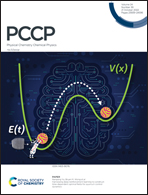New theoretical investigation of rotational inelastic (de)-excitation of calcium isocyanide CaNC(2Σ+) in collision with He(1S)
Abstract
The theoretical study of collisions between atoms and molecules provides a detailed description of the involved mechanisms and greatly contributes to improving atmospheric and astrophysics models. In the present paper, we focus on the new calculation of rate coefficients for the first 25 rotational levels of the CaNC molecule in collision with He. A new 2D potential energy surface (2D-PES), for the CaNC–He system, was determined using the single, double and perturbative triple excitation restricted coupled-cluster method [rccsd(t)] and the standard aug-cc-pVQZ basis sets. This PES presents a global minimum with a well depth of −21.93 cm−1 located at R = 8a0 and γ = 116°. State-to-state collisional excitation cross-sections of the fine-structure levels of CaNC(2Σ+)–He are calculated for energies up to 305 cm−1, which yield, after thermal averaging, rate coefficients up to 70 K. A ΔJ = ΔN propensity rule was observed. A comparison of the CaNC rates with those of valence isoelectronic MgNC has been investigated. These new data are necessary for the CaNC abundance determination and interpretation of its observed lines.



 Please wait while we load your content...
Please wait while we load your content...